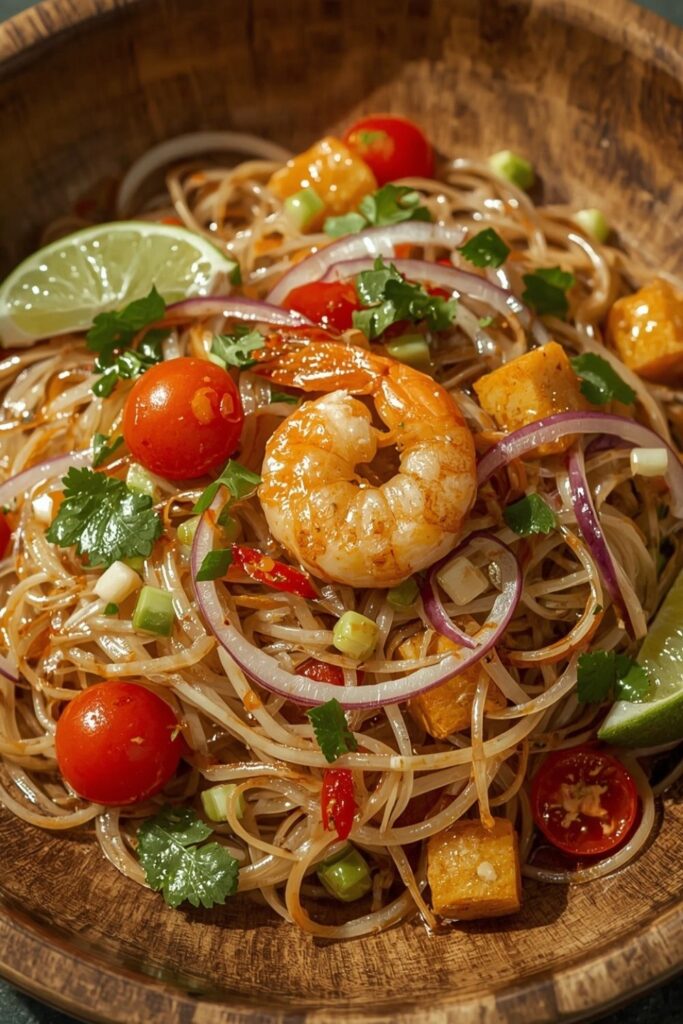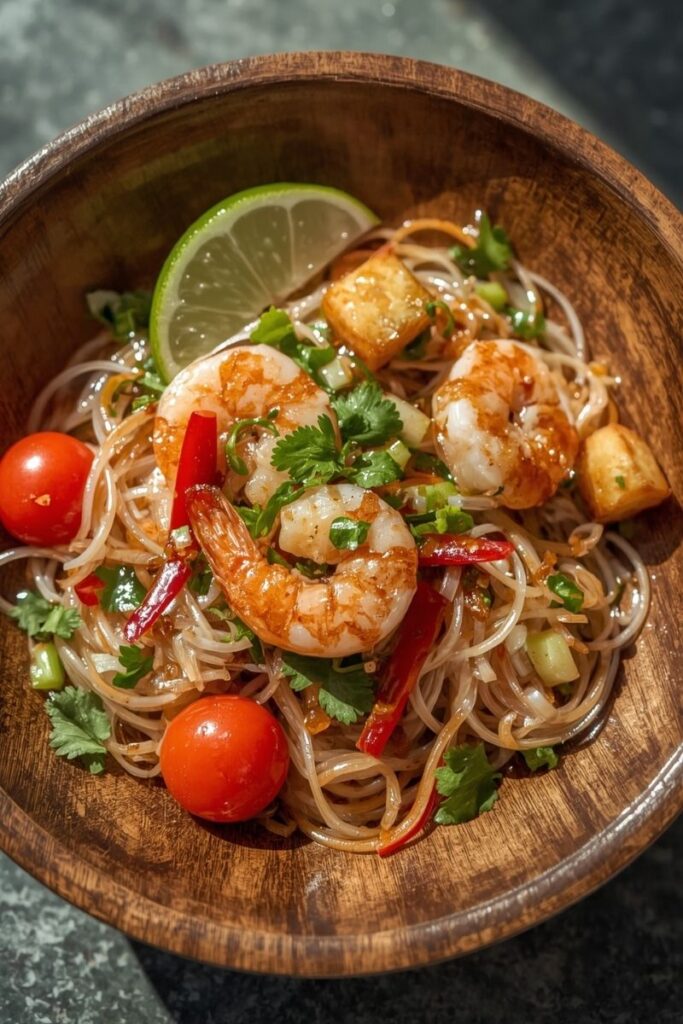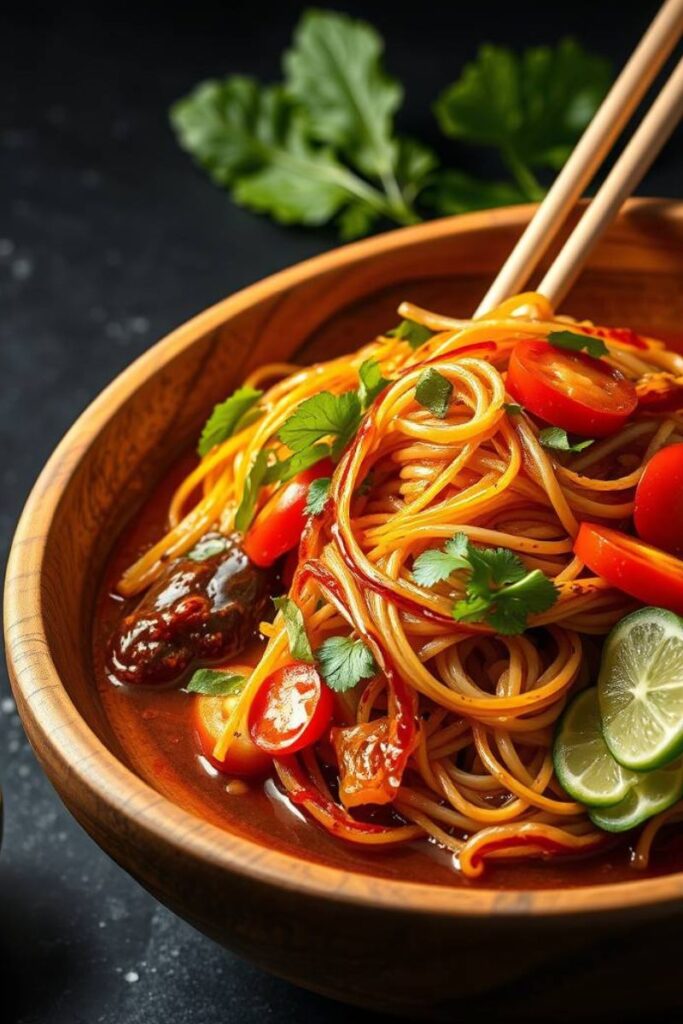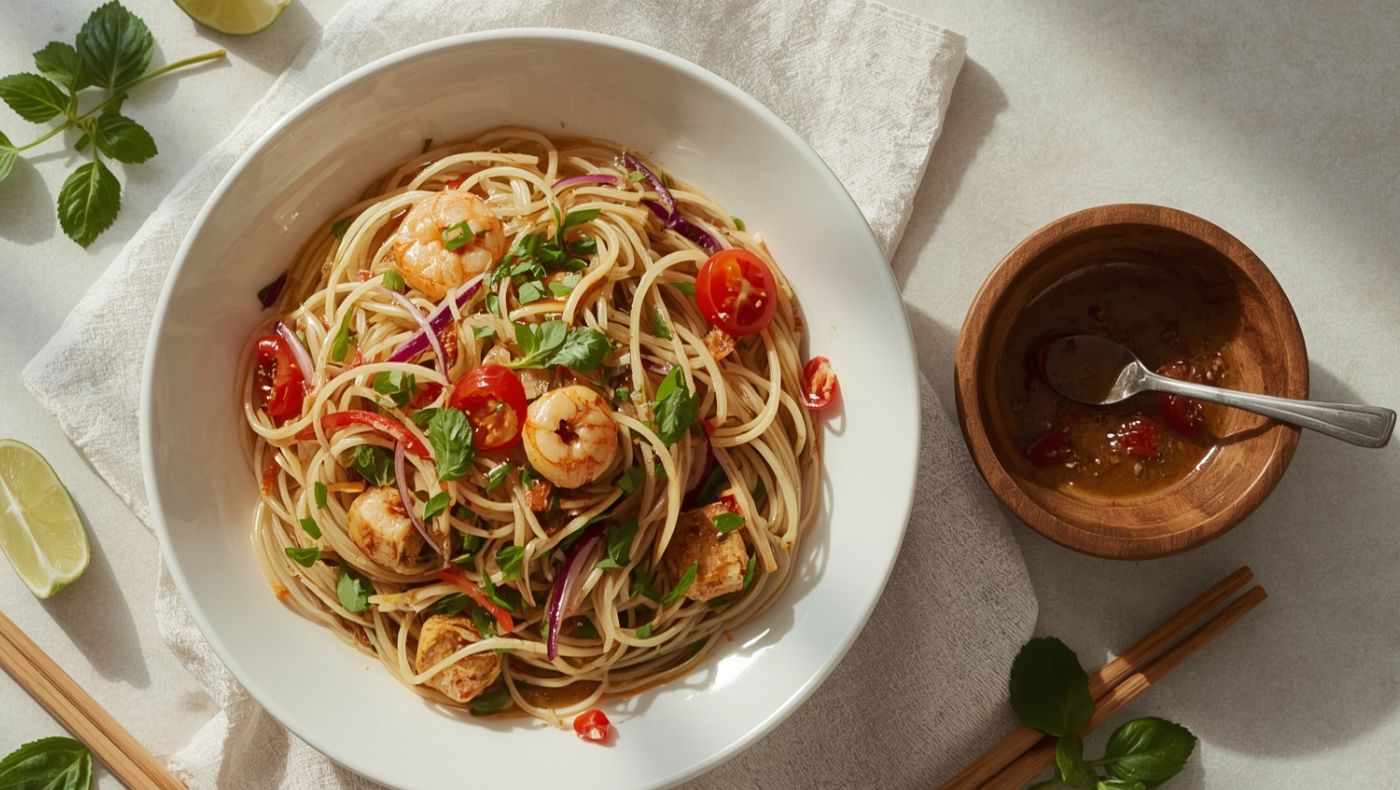Ever tasted something so fresh, spicy, and tangy you had to go back for seconds? That’s exactly what Thai Noodle Salad is all about. The first time I tried this dish, it was at a tiny street stall in Bangkok. One bite, and I was hooked. Cool noodles. Crunchy veggies. Zesty lime. Just the right heat. Every bite exploded with flavor.
This recipe brings that same street style magic, right into your kitchen. Thai Noodle Salad doesn’t need fancy skills or hard to find ingredients. If you can boil noodles and chop veggies, you’re in. You’ll learn how to mix a quick dressing that’s equal parts spicy, sweet, salty, and sour. You’ll also get tips to keep your veggies crisp and your noodles from clumping.
Want something light but satisfying? Quick but impressive? Thai Noodle Salad checks every box. It’s perfect for lunch, picnics, or a side that steals the show. You’ll walk away with a no fail, crowd pleasing recipe and maybe even a new go to favorite. Let’s dive in!
Ingredients & Substitutions
The Noodle Foundation
Glass noodles create the perfect base. These translucent beauties soak up flavors like magic. Mung bean starch keeps them bouncy when cold. Can’t find glass noodles? Rice vermicelli works too. Different texture. Still delicious.
Soak them in warm water. Not hot, warm. Fifteen minutes works. They should bend easily. Still need bite. Over soak equals mushy noodles. Nobody wants mush.
Protein Power
Fresh shrimp brings sweetness and snap. Medium sized works best. Big enough to notice. Small enough to distribute evenly. Cook until just pink. Two minutes max. Ice bath stops cooking instantly.
No shrimp? Cooked chicken breast works perfectly. Shred it fine. Turkey works too. Vegetarians use pressed tofu cubes. Adds protein. Doesn’t change flavor.
Ground pork adds richness that many recipes skip. Cook it dry no oil needed. The pork renders its own fat. Small pieces distribute better. Cook until just done. Dry pork ruins the whole dish.
The Crunch Factor in Thai Noodle Salad
Thai shallots beat regular onions every time. Sharper flavor. Cleaner bite. Purple tinged. Potent. Can’t find them? Red onions work. Slice paper thin. Soak in cold water ten minutes. Tames the bite.
Celery adds unexpected crunch. Sounds weird. It works. Slight bitterness balances sweetness. Chinese celery is traditional. Regular celery chopped fine works too.
Fresh chilies control the heat. Thai bird’s eye chilies pack serious punch. Start with one. Build from there. Serrano peppers substitute well. Jalapeños work for mild heat lovers.
Herb Magic in Thai Noodle Salad
Fresh herbs transform this salad. Good becomes incredible. Thai basil has anise like flavor. Regular basil can’t match it. Purple tinged leaves. Complex taste. No Thai basil? Mix regular basil with fresh mint.
Cilantro adds brightness. Some people hate it. Genetic thing. For them, extra Thai basil works. Or more mint. Use lots of herbs. They aren’t garnish here. They’re main players.
Mint provides cooling contrast. Spearmint beats peppermint. Too strong otherwise. Tear the leaves by hand. Knives bruise them. Bruised herbs turn black and bitter.
The Dressing Components
Fish sauce creates the umami backbone. Not all brands taste the same. Look for amber color. Short ingredient lists. Vegetarians can use mushroom sauce. Add seaweed powder for ocean flavor.
Palm sugar brings caramel sweetness. Coconut sugar substitutes well. Brown sugar works in a pinch. Dissolve it completely. Gritty sugar ruins the smooth dressing.
Fresh lime juice provides essential sourness. Bottled stuff won’t cut it. The oils in fresh lime zest matter. Lemon juice substitutes but lacks lime’s particular brightness.
How to Make Thai Noodle Salad: Step by Step

Prep the Noodles Right
Start with warm water. Not hot. Hot water makes them mushy. Soak for fifteen to twenty minutes. Test them they should bend without breaking. Still have some firmness. They’ll soften more in the dressing.
Drain thoroughly. Really thoroughly. Excess water dilutes the dressing. Shake them in the strainer. Pat with paper towels if needed. Wet noodles equal weak flavors.
Cook Proteins Perfectly
Bring salted water to a rolling boil for shrimp. Add them. Count to 120. They should be pink and curled. Straight into ice water. Overcooked shrimp turn rubbery. Nobody wants rubber in their salad.
For ground pork, use a dry pan. Medium high heat. Break it up as it cooks. No oil needed. Cook until just done. About five minutes. Still moist but no pink. Dry pork tastes like cardboard.
Master the Dressing for Thai Noodle Salad
Mix palm sugar with lime juice first. Stir until dissolved. Takes a few minutes. Add fish sauce gradually. Taste as you go. Ratio: roughly 3:2:1. Lime, fish sauce, sugar. Adjust to taste.
Add minced garlic and chopped chilies. Let it sit ten minutes. Flavors need time to marry. Garlic mellows. Chilies infuse heat throughout.
Assembly Secrets
Add warm noodles to the dressing. Toss gently. Every strand should be coated. Don’t break them. Gentle hands win here.
Add proteins while slightly warm. They absorb flavors better. Cold proteins stay cold. Warm proteins drink up the dressing.
Vegetables go in next. Shallots, celery, tomatoes. Cherry tomatoes work great. Quarter them. Their juice adds brightness. Mix everything carefully.
The Herb Finale in Thai Noodle Salad
Save herbs for last. Add them just before serving. Heat wilts them. Wilted herbs look sad. Fold them in with your hands. Gentler than spoons.
Taste and adjust. Need more lime? Add it. Want more heat? Another chili. Too salty? Pinch of sugar balances it. Perfect balance takes practice.
Cooking Techniques & Science Behind Thai Noodle Salad
Understanding Thai Heat
Thai cuisine builds heat in layers. Not just hot. Complex hot. Chilies add flavor, not just fire. Different parts have different heat levels. Seeds pack the most punch. Flesh gives flavor with moderate heat.
Remove seeds for less heat. Keep flesh for flavor. Professional cooks separate them. Use flesh for taste. Use seeds for heat adjustment. Smart technique.
Noodle Science
Glass noodles work differently than wheat noodles. No gluten. Stay bouncy when cold. Mung bean starch gelatinizes when heated. Creates translucent look.
Temperature matters during soaking. Too hot equals mush. Too cool equals tough. Warm water hits sweet spot. Around 70-80°C works perfectly.
Flavor Balance Principles
Thai cooking balances four tastes: sweet, sour, salty, spicy. Each should be present. None should dominate. The art lies in harmony, not competition.
Fish sauce acts as flavor amplifier. Makes other tastes more intense. That’s why Thai food seems so flavorful. Umami enhances everything.
Serving & Pairing Suggestions

Presentation Matters
Serve family style in large, shallow bowl. Shows off all colors. Translucent noodles make beautiful backdrop. Individual plating works too. Twirl noodles with tongs. Create height. Arrange proteins on top.
Scatter herbs as final garnish. Add lime wedges. Let people adjust acidity. Chilled plates keep everything cool. Room temperature tastes best though.
Perfect Pairings
This salad shines with grilled meats. Fresh, acidic flavors cut through rich, smoky tastes. Serve with som tam and grilled chicken. Authentic street food experience.
Beer works beautifully. Light lagers complement the brightness. Singha or Chang are traditional. Any crisp beer works. Wine lovers should choose high acid whites. Sauvignon Blanc or Albariño.
Timing Tips
Room temperature brings out best flavors. Cold mutes the herbs. Let it sit fifteen minutes after mixing. Flavors meld better. Don’t wait more than two hours though. Herbs start wilting.
The salad improves slightly after sitting. Noodles absorb more dressing. But fresh herbs are crucial. Add them last. Keep them vibrant.
Advanced Tips & Variations for Thai Noodle Salad
Seasonal Additions
Summer calls for cucumber. Adds cooling crunch. Thinly sliced radishes provide peppery bite in cooler months. Maintain the balance though. Don’t overwhelm the core flavors.
Green papaya works wonderfully. Julienned thin. Adds som tam vibes. Bean sprouts give extra crunch. Blanch them quickly. Raw ones can be tough.
Protein Variations
Grilled beef works excellently. Slice it thin. Let it cool slightly before adding. Grilled chicken breast, shredded fine. Even leftover roast pork.
For seafood lovers, try cooked crab meat. Expensive but worth it. Scallops work too. Cook them properly seared outside, tender inside.
Make Ahead Strategies
Prep components separately. Store in fridge. Assemble just before serving. Dressing keeps three days. Cooked proteins keep two days. Vegetables stay crisp overnight.
Never assemble completely ahead. Noodles get oversaturated. Herbs wilt. Fresh assembly equals fresh taste.
Troubleshooting Common Issues
Mushy Noodles
Over soaking causes mushiness. Start over with fresh noodles. Can’t salvage mushy ones. Water too hot also causes problems. Warm water only.
Bland Flavors
Usually means weak dressing. Taste it separately. Should be intense. Sweet, sour, salty, spicy. Adjust each element. Don’t be timid with seasonings.
Wilted Herbs
Added too early. Or salad sat too long. Fresh herbs are crucial. Add them last minute. Keep extras for garnish.
Clumpy Noodles
Didn’t drain well enough. Or stirred too vigorously. Drain thoroughly. Toss gently. Patience wins here.
Storage & Leftovers for Thai Noodle Salad

Store leftovers in airtight containers. Refrigerate up to 24 hours. Let come to room temperature before serving. May need fresh lime juice. Flavors fade over time.
Don’t freeze Thai Noodle Salad. Texture becomes awful. Fresh herbs turn black. Noodles get weird. This dish is best fresh.
Final Thoughts on Thai Noodle Salad
Thai Noodle Salad delivers exactly what it promises. Big flavors. Simple technique. No complicated skills required. Master the dressing balance. Respect the ingredients. Keep it fresh.
This isn’t just another pasta salad. It’s a lesson in Thai cooking principles. Sweet, sour, salty, spicy. All in harmony. The kind of dish that converts people. Makes them crave more Thai food.
Start with quality ingredients. Follow the techniques. Trust your taste buds. Adjust as needed. Soon you’ll make this salad without measuring. Tasting and adjusting like a pro.
Thai Noodle Salad isn’t just a recipe. It’s your gateway to understanding Thai cuisine. Master this dish, and you’ll have a crowd pleaser. Restaurant quality results with minimal effort. Bold flavors, no fuss, maximum impact.
FAQs about Thai Noodle Salad
Q: Can I make Thai Noodle Salad ahead of time?
A: Partially, yes. Prep the dressing, cook proteins, and chop vegetables up to a day ahead. Soak noodles and add fresh herbs just before serving. Complete assembly holds well for 2-3 hours maximum.
Q: What if I can’t find glass noodles?
A: Rice vermicelli makes the best substitute. Slightly different texture but still delicious. Thin rice noodles work too. Avoid wheat based noodles they don’t absorb flavors the same way.
Q: How do I control the spice level?
A: Start with one small chili. Remove seeds and membranes for less heat. Taste the dressing before adding to noodles. Add more chilies gradually. Too spicy? Add more palm sugar to balance.
Q: Can I make this vegetarian?
A: Absolutely! Skip the shrimp and pork. Use pressed tofu cubes instead. Replace fish sauce with mushroom sauce or soy sauce mixed with seaweed powder. All other ingredients stay the same.
Q: Why do my noodles clump together?
A: Usually means they weren’t drained thoroughly. Excess water makes them stick. Shake them well in the strainer. Pat with paper towels if needed. Toss gently when mixing rough handling causes clumping.

Swiftly Captions by Tina Smith — Quick, flavorful food recipes made simple, bringing fresh inspiration to your kitchen every day






